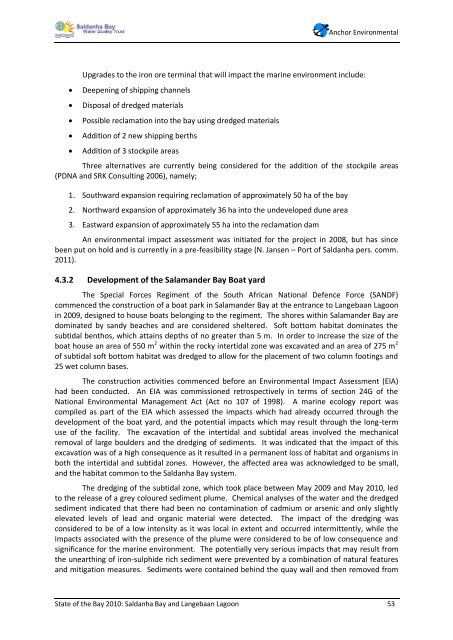State of the Bay Report 2010-Final - Anchor Environmental
State of the Bay Report 2010-Final - Anchor Environmental
State of the Bay Report 2010-Final - Anchor Environmental
You also want an ePaper? Increase the reach of your titles
YUMPU automatically turns print PDFs into web optimized ePapers that Google loves.
<strong>Anchor</strong> <strong>Environmental</strong><br />
Upgrades to <strong>the</strong> iron ore terminal that will impact <strong>the</strong> marine environment include:<br />
Deepening <strong>of</strong> shipping channels<br />
Disposal <strong>of</strong> dredged materials<br />
Possible reclamation into <strong>the</strong> bay using dredged materials<br />
Addition <strong>of</strong> 2 new shipping berths<br />
Addition <strong>of</strong> 3 stockpile areas<br />
Three alternatives are currently being considered for <strong>the</strong> addition <strong>of</strong> <strong>the</strong> stockpile areas<br />
(PDNA and SRK Consulting 2006), namely;<br />
1. Southward expansion requiring reclamation <strong>of</strong> approximately 50 ha <strong>of</strong> <strong>the</strong> bay<br />
2. Northward expansion <strong>of</strong> approximately 36 ha into <strong>the</strong> undeveloped dune area<br />
3. Eastward expansion <strong>of</strong> approximately 55 ha into <strong>the</strong> reclamation dam<br />
An environmental impact assessment was initiated for <strong>the</strong> project in 2008, but has since<br />
been put on hold and is currently in a pre-feasibility stage (N. Jansen – Port <strong>of</strong> Saldanha pers. comm.<br />
2011).<br />
4.3.2 Development <strong>of</strong> <strong>the</strong> Salamander <strong>Bay</strong> Boat yard<br />
The Special Forces Regiment <strong>of</strong> <strong>the</strong> South African National Defence Force (SANDF)<br />
commenced <strong>the</strong> construction <strong>of</strong> a boat park in Salamander <strong>Bay</strong> at <strong>the</strong> entrance to Langebaan Lagoon<br />
in 2009, designed to house boats belonging to <strong>the</strong> regiment. The shores within Salamander <strong>Bay</strong> are<br />
dominated by sandy beaches and are considered sheltered. S<strong>of</strong>t bottom habitat dominates <strong>the</strong><br />
subtidal benthos, which attains depths <strong>of</strong> no greater than 5 m. In order to increase <strong>the</strong> size <strong>of</strong> <strong>the</strong><br />
boat house an area <strong>of</strong> 550 m 2 within <strong>the</strong> rocky intertidal zone was excavated and an area <strong>of</strong> 275 m 2<br />
<strong>of</strong> subtidal s<strong>of</strong>t bottom habitat was dredged to allow for <strong>the</strong> placement <strong>of</strong> two column footings and<br />
25 wet column bases.<br />
The construction activities commenced before an <strong>Environmental</strong> Impact Assessment (EIA)<br />
had been conducted. An EIA was commissioned retrospectively in terms <strong>of</strong> section 24G <strong>of</strong> <strong>the</strong><br />
National <strong>Environmental</strong> Management Act (Act no 107 <strong>of</strong> 1998). A marine ecology report was<br />
compiled as part <strong>of</strong> <strong>the</strong> EIA which assessed <strong>the</strong> impacts which had already occurred through <strong>the</strong><br />
development <strong>of</strong> <strong>the</strong> boat yard, and <strong>the</strong> potential impacts which may result through <strong>the</strong> long-term<br />
use <strong>of</strong> <strong>the</strong> facility. The excavation <strong>of</strong> <strong>the</strong> intertidal and subtidal areas involved <strong>the</strong> mechanical<br />
removal <strong>of</strong> large boulders and <strong>the</strong> dredging <strong>of</strong> sediments. It was indicated that <strong>the</strong> impact <strong>of</strong> this<br />
excavation was <strong>of</strong> a high consequence as it resulted in a permanent loss <strong>of</strong> habitat and organisms in<br />
both <strong>the</strong> intertidal and subtidal zones. However, <strong>the</strong> affected area was acknowledged to be small,<br />
and <strong>the</strong> habitat common to <strong>the</strong> Saldanha <strong>Bay</strong> system.<br />
The dredging <strong>of</strong> <strong>the</strong> subtidal zone, which took place between May 2009 and May <strong>2010</strong>, led<br />
to <strong>the</strong> release <strong>of</strong> a grey coloured sediment plume. Chemical analyses <strong>of</strong> <strong>the</strong> water and <strong>the</strong> dredged<br />
sediment indicated that <strong>the</strong>re had been no contamination <strong>of</strong> cadmium or arsenic and only slightly<br />
elevated levels <strong>of</strong> lead and organic material were detected. The impact <strong>of</strong> <strong>the</strong> dredging was<br />
considered to be <strong>of</strong> a low intensity as it was local in extent and occurred intermittently, while <strong>the</strong><br />
impacts associated with <strong>the</strong> presence <strong>of</strong> <strong>the</strong> plume were considered to be <strong>of</strong> low consequence and<br />
significance for <strong>the</strong> marine environment. The potentially very serious impacts that may result from<br />
<strong>the</strong> unearthing <strong>of</strong> iron-sulphide rich sediment were prevented by a combination <strong>of</strong> natural features<br />
and mitigation measures. Sediments were contained behind <strong>the</strong> quay wall and <strong>the</strong>n removed from<br />
<strong>State</strong> <strong>of</strong> <strong>the</strong> <strong>Bay</strong> <strong>2010</strong>: Saldanha <strong>Bay</strong> and Langebaan Lagoon 53

















